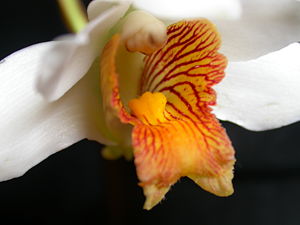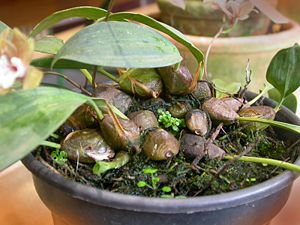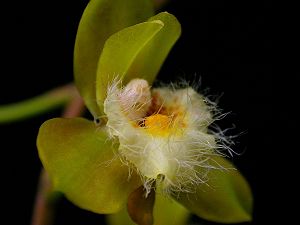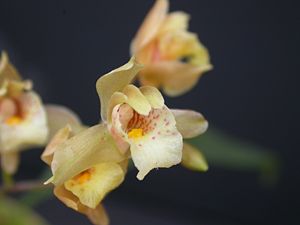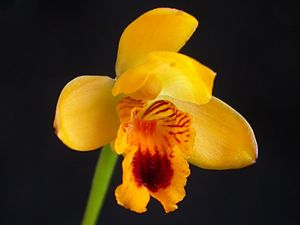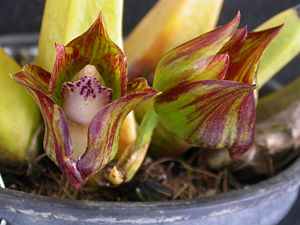Bifrenaria: Difference between revisions
imported>Meg Taylor m (spelling: normaly -> normally) |
Pat Palmer (talk | contribs) mNo edit summary |
||
| (9 intermediate revisions by 3 users not shown) | |||
| Line 28: | Line 28: | ||
*''Cydoniorchis''<small> [[Senghas]] 1994</small> | *''Cydoniorchis''<small> [[Senghas]] 1994</small> | ||
}} | }} | ||
'''''[[Bifrenaria]]''''' is a genus of [[orchid]]s containing twenty [[South America|South American]] [[species]]. some of which rank among the favorites of orchid growers because of their abundant showy [[flower]]s, which are large and very fleshy and at first glance seem to be artificial flowers made of [[wax]]. There are no known uses for them other than ornamental. | |||
Despite having few species, the genus can be split in two clearly distinct groups:<ref name="Cogn"><span style="font-variant:small-caps;">Cogniaux, Celestin A.</span>(1902). ''Bifrenaria'' in Flora Brasiliensis K.F.P.von Martius & auct. suc. (eds.) vol.3 p. 5: 476. [http://florabrasiliensis.cria.org.br/search?taxon_id=237 published on Internet.]</ref> one of highly robust plants with large flowers, that encompass the first species to be classified under the genus ''Bifrenaria''; other of more delicate plants with smaller flowers occasionally denominated ''Stenocoryne'' or ''Adipe''. There are yet two other species that normally are classified as ''Bifrenaria'' but which molecular analysis indicate to belong to different orchid groups. They are ''Bifrenaria grandis'', endemic of [[Bolívia]], which many [[taxonomist]]s denominate ''[[Lacaena|Lacaena grandis]]'',<ref><span style="font-variant:small-caps;">Kraenzlin, Friedrich Wilhelm Ludwig</span> (1928). ''Lacaena grandis'' in Repertorium specierum novarum regni vegetabilis. Ed. Selbstverlag des Herausgebers, Berlin, at vol.25: 25.</ref> and ''[[Bifrenaria steyermarkii]]'', inhabitant of northern [[Amazon Forest]],<ref><span style="font-variant:small-caps;">Dunsterville, Galfried Clement Keyworth & Garay, Leslie A.</span> (1976). ''Bifrenaria steyermarkii'' in Venezuelan Orchids Illustrated vol.6: 56. London.</ref> which does not have an alternative classification as yet. | |||
==Distribution== | ==Distribution== | ||
{{Image|Bifrenaria inodora 44.jpg|left|300px|'''''Bifrenaria inodora'''''<br><small>Despite described with the name of ''B. inodora'', this large species is one of the most fragrant ''Bifrenaria''. It has two main varieties, the one on the photo was also described as ''B. fuerstenbergiana'' and has this varietal name, the other one is greener and has a yellow labellum.</small>}} | {{Image|Bifrenaria inodora 44.jpg|left|300px|'''''Bifrenaria inodora'''''<br><small>Despite described with the name of ''B. inodora'', this large species is one of the most fragrant ''Bifrenaria''. It has two main varieties, the one on the photo was also described as ''B. fuerstenbergiana'' and has this varietal name, the other one is greener and has a yellow labellum.</small>}} | ||
''Bifrenaria'' exist from the north of South America, one species reaching [[Trinidad]], until [[Rio Grande do Sul]], the farther south State in [[Brazil]], however they are split in two isolated areas:<ref name="Kew"><span style="font-variant:small-caps;">R. Govaerts, M.A. Campacci (Brazil, 2005), D. Holland Baptista (Brazil, 2005), P.Cribb (K, 2003), Alex George (K, 2003), K.Kreuz (2004, Europe), J.Wood (K, 2003, Europe)</span>: World Checklist of Orchidaceae. The Board of Trustees of the Royal Botanic Gardens, Kew. [http://www.kew.org/wcsp Published on the Internet.] (Access March 2009).</ref> Amazon Forest and [[Atlantic Forest]] of Brazil. The later, where seventeen species are present, may be considered their | ''Bifrenaria'' exist from the north of South America, one species reaching [[Trinidad]], until [[Rio Grande do Sul]], the farther south State in [[Brazil]], however they are split in two isolated areas:<ref name="Kew"><span style="font-variant:small-caps;">R. Govaerts, M.A. Campacci (Brazil, 2005), D. Holland Baptista (Brazil, 2005), P.Cribb (K, 2003), Alex George (K, 2003), K.Kreuz (2004, Europe), J.Wood (K, 2003, Europe)</span>: World Checklist of Orchidaceae. The Board of Trustees of the Royal Botanic Gardens, Kew. [http://www.kew.org/wcsp Published on the Internet.] (Access March 2009).</ref> Amazon Forest and [[Atlantic Forest]] of Brazil. The later, where seventeen species are present, may be considered their recent center of distribution. The mountain area of [[Rio de Janeiro State]] and [[Espírito Santo]] is particularly rich with fifteen species registered. [[Serra dos Órgãos]] mountains area, in Rio, is reported as habitat of fourteen ''Bifrenaria'' species,<ref name="DM"><span style="font-variant:small-caps;">Miller, David , Richard Warren, Izabel Moura Miller & Helmut Seehawer</span> (2006). Serra dos Órgãos sua história e suas orquídeas. Rio de Janeiro.</ref> however, some of these species are considered synonyms today,<ref><span style="font-variant:small-caps;">Koehler, S. & do Amaral, M.D.E.</span> (2004). A taxonomic study of the South American genus ''Bifrenaria'' Lindl. (Orchidaceae). Brittonia 56: 314-345.</ref> being eleven a more realistic number of species existing in the said area. | ||
The species with large flowers are more common on [[Region Southeast of Brazil]], however, they inhabit from the sunnier areas of the seashore to rocky mountain areas of [[Minas Gerais]] e [[Bahia]] States, from almost sea level up to 2,000 meters of [[altitude]], some species reaching [[Rio Grande do Sul]] state.<ref name="IOBBA"><span style="font-variant:small-caps;">Castro Neto, Vitorino P. </span> (2006). ''Bifrenaria atropurpurea'' in Icones Orchidacearum Brasilienses. ISBN 8590149447</ref> No species of large flowers exist in Amazon Forest. Some species grow directly attached to the famous [[Sugarloaf Mountain]] in Rio de Janeiro which can be observed by the commuters in the cable car. The recent centers of irradiation of this group are the seashore close to [[Serra do Mar]] chain of mountains, and the high chains of mountains of Minas Gerais.<ref name="FB"><span style="font-variant:small-caps;">Frederico C. Hoehne</span> (1953). ''Bifrenaria'' in Flora Brasílica, Vol 12: 7. Instituto de Botânica de São Paulo.</ref> The most common species in this group, spread from Rio Grande do Sul to Bahia, is ''[[Bifrenaria harrisoniae|B. harrisoniae]]''.<ref name="IOBBH"><span style="font-variant:small-caps;">Castro Neto, Vitorino P. </span> (2006). ''Bifrenaria harrisoniae'' in Icones Orchidacearum Brasilienses. ISBN 8590149447</ref> | The species with large flowers are more common on [[Region Southeast of Brazil]], however, they inhabit from the sunnier areas of the seashore to rocky mountain areas of [[Minas Gerais]] e [[Bahia]] States, from almost sea level up to 2,000 meters of [[altitude]], some species reaching [[Rio Grande do Sul]] state.<ref name="IOBBA"><span style="font-variant:small-caps;">Castro Neto, Vitorino P. </span> (2006). ''Bifrenaria atropurpurea'' in Icones Orchidacearum Brasilienses. ISBN 8590149447</ref> No species of large flowers exist in Amazon Forest. Some species grow directly attached to the famous [[Sugarloaf Mountain]] in Rio de Janeiro which can be observed by the commuters in the cable car. The recent centers of irradiation of this group are the seashore close to [[Serra do Mar]] chain of mountains, and the high chains of mountains of Minas Gerais.<ref name="FB"><span style="font-variant:small-caps;">Frederico C. Hoehne</span> (1953). ''Bifrenaria'' in Flora Brasílica, Vol 12: 7. Instituto de Botânica de São Paulo.</ref> The most common species in this group, spread from Rio Grande do Sul to Bahia, is ''[[Bifrenaria harrisoniae|B. harrisoniae]]''.<ref name="IOBBH"><span style="font-variant:small-caps;">Castro Neto, Vitorino P. </span> (2006). ''Bifrenaria harrisoniae'' in Icones Orchidacearum Brasilienses. ISBN 8590149447</ref> | ||
The smaller species of ''Bifrenaria'', which some taxonomists classify under the genus ''Adipe'', are more common on less sunny areas and can be found between 300 and about 1,600 meters of altitude.<ref name="DM"/> Six species are native in Serra do Mar Chain of mountains and its arms, place considered the center of distribution of the small species. Only three small species inhabit Amazon, ''[[Bifrenaria longicornis|B. longicornis]]'', which is more | The smaller species of ''Bifrenaria'', which some taxonomists classify under the genus ''Adipe'', are more common on less sunny areas and can be found between 300 and about 1,600 meters of altitude.<ref name="DM"/> Six species are native in Serra do Mar Chain of mountains and its arms, place considered the center of distribution of the small species. Only three small species inhabit Amazon, ''[[Bifrenaria longicornis|B. longicornis]]'', which is more common at low altitudes;<ref name="Tese"><span style="font-variant:small-caps;">Koehler, Samantha</span> (2001). Estudo taxonômico e análise cladástica do complexo ''Bifrenaria'' Lindl. (Maxillarieae, Orchidaceae). Universidade Estadual de Campinas. Instituto de Biologia. [http://libdigi.unicamp.br/document/?code=vtls000241393 Published on the Internet]</ref> ''[[Bifrenaria venezuelana]]'', up to 1,450 meter of altitude, and ''[[Bifrenaria steyermarkii|B. steyermarkii]]'' from even higher altitudes, in [[Roraima]] State, in Brazil, and nearby areas in [[Venezuela]] and [[Surinam]].<ref><span style="font-variant:small-caps;">Freitas Luz, Francisco J.</span> (2001). Orquídeas na Amazônia. Instituto Brasileiro de Cultura, Ed. On Line. ISBN 8520802087</ref> | ||
The most common species is ''[[Bifrenaria aureofulva|B. aureofulva]]'',<ref name="EdwardsBA"><span style="font-variant:small-caps;">Lindley, John</span> (1843). ''Bifrenaria aureofulva'' in Edwards's botanical register 29: t.52. Ed. James Ridgway, London.</ref> however, because the geographic characteristic of its territory, without obstacles, ''[[Bifrenaria longicornis|B. longicornis]]'' is the species spread | The most common species is ''[[Bifrenaria aureofulva|B. aureofulva]]'',<ref name="EdwardsBA"><span style="font-variant:small-caps;">Lindley, John</span> (1843). ''Bifrenaria aureofulva'' in Edwards's botanical register 29: t.52. Ed. James Ridgway, London.</ref> however, because the geographic characteristic of its territory, without obstacles, ''[[Bifrenaria longicornis|B. longicornis]]'' is the species spread throughout the largest area, reaching [[Colombia]], [[Venezuela]], [[Peru]], [[Surinam]], [[Guyana]]s, Trinidad and all Amazonic area in Brazil.<ref name="EdwardsBL"><span style="font-variant:small-caps;">Lindley, John</span> (1838). ''Bifrenaria longicornis'' in Edwards's botanical register 24: t.93. Ed. James Ridgway, London.</ref> Two species seem to be [[endemic]] in highly restricted areas: ''[[Bifrenaria silvana|B. silvana]]''. discovered in 1987 at [[Serra da Ouricana]] mountains, nearby [[Itororó]], in [[Bahia]] which belongs to ''Adipe'' group;<ref><span style="font-variant:small-caps;">Castro Neto, Vitorino P.</span> (1991). ''Bifrenaria silvana'' in Boletim CAOB 3(4): 41.</ref> and ''[[Bifrenaria verboonenii|B. verboonenii]]'', discovered in September 1995 on [[Serra do Cipó]] mountains, close to [[Diamantina]], [[Minas Gerais]], of the large ''Bifrenara'' group.<ref><span style="font-variant:small-caps;">Romero, Gustavo A. & Castro Neto, Vitorino P.</span> (2000). ''Bifrenaria verboonenii'' in Harvard Papers of Botany 5: 187 Cambridge.</ref> | ||
{{Image|Bifrenaria harrisoniae 0.jpg|right|300px|'''''Bifrenaria harrisoniae'''''<br><small>This is the most variable species of all ''Bifrenaria'': there are numberless colors varieties. It can be distinguished from ''B. tyrianthyna'' only through its three keeled callus and shorter calcar.</small>}} | {{Image|Bifrenaria harrisoniae 0.jpg|right|300px|'''''Bifrenaria harrisoniae'''''<br><small>This is the most variable species of all ''Bifrenaria'': there are numberless colors varieties. It can be distinguished from ''B. tyrianthyna'' only through its three keeled callus and shorter calcar.</small>}} | ||
| Line 55: | Line 54: | ||
''Bifrenaria'' generally are robust plants, of [[sympodial growth]], which measure between ten and sixty centimeters height. Characteristics of an orchid to be classified under this genus are: to show [[root]]s of round section with thick [[vellamen]]; four angled fleshy [[pseudobulb]]s of one internode, often basally protected by dried steaths and with only one apical [[leaf]], except for ''Bifrenaria steyermarkii'', which occasionally has two;<ref><span style="font-variant:small-caps;">Foldats, Ernesto</span> (1970). ''Xylobium steyermarkii'' em Novedades Cientificas, Contribuciones Occasionales del Museo de Historia Natural La Salle vol.35: 1. Serie Botanica. Caracas.</ref> plicate enervated leathery leaves, yet malleable and not exceedingly thick, with a pseudopetiole of basal round section; basal [[inflorescence]]s bearing up to ten flowers, which seldom surpass the leaves length.<ref name="FB"/> | ''Bifrenaria'' generally are robust plants, of [[sympodial growth]], which measure between ten and sixty centimeters height. Characteristics of an orchid to be classified under this genus are: to show [[root]]s of round section with thick [[vellamen]]; four angled fleshy [[pseudobulb]]s of one internode, often basally protected by dried steaths and with only one apical [[leaf]], except for ''Bifrenaria steyermarkii'', which occasionally has two;<ref><span style="font-variant:small-caps;">Foldats, Ernesto</span> (1970). ''Xylobium steyermarkii'' em Novedades Cientificas, Contribuciones Occasionales del Museo de Historia Natural La Salle vol.35: 1. Serie Botanica. Caracas.</ref> plicate enervated leathery leaves, yet malleable and not exceedingly thick, with a pseudopetiole of basal round section; basal [[inflorescence]]s bearing up to ten flowers, which seldom surpass the leaves length.<ref name="FB"/> | ||
''Bifrenaria'' flowers are fragrant or have a strong scent, they have sepals slightly larger than the petals, the lateral ones basally united to the [[column (botany|column]] foot forming a [[calcar]] with truncated extremity; labellum variously shaped, often hairy, articulated to the column, with a longitudinal channeled callus often with a basal claw; the column is slightly arching, generally without wings or any other appendages, bearing a foot which the labellum is hinged to; they show two elongated [[stipe]]s, hardy ever one, at least twice longer than wide, | ''Bifrenaria'' flowers are fragrant or have a strong scent, they have sepals slightly larger than the petals, the lateral ones basally united to the [[column (botany|column]] foot forming a [[calcar]] with truncated extremity; labellum variously shaped, often hairy, articulated to the column, with a longitudinal channeled callus often with a basal claw; the column is slightly arching, generally without wings or any other appendages, bearing a foot which the labellum is hinged to; they show two elongated [[stipe]]s, hardy ever one, at least twice longer than wide, with salient [[viscidium]], visible [[caudicle]]s and [[retinacle]] in inverted positions; four hard superposed [[pollinia]], protected by a deciduous incumbent [[anther]].<ref name="Tese"/> The fruits are green, erect or pending, take about eight months to ripe and hold hundreds of thousand yellowish or brownish elongated seeds up to 0.35 mm long.<ref><span style="font-variant:small-caps;">Dressler, Robert L.</span> (1993). Phylogeny and classification of the orchid family. Cambridge University Press.</ref> Among all the mentioned, the main characteristic to distinguish ''Bifrenaria'' form its related genera is the presence of the calcar on its flowers.<ref name="FB"/> Other important qualities are the four sided unifoliated pseudobulbs besides the raceme inflorescence with to ten flowers.<ref name="Campa"><span style="font-variant:small-caps;">Campacci, Marcos A.</span> (2003). Coletânea de Orquídeas Brasileiras II, ''Bifrenaria''. Ed. Brasil Orquídeas. ISSN 16785606</ref> | ||
Few is known about ''Bifrenaria'' species pollination. Apparently the only existing records report the presence of some large species' pollinaria observed on the back of male ''[[Eufriesea violacea]]'', [[Euglossinae]] [[bee]]s,<ref><span style="font-variant:small-caps;">Dressler, Robert L.</span> (1990). The orchids natural history and classification. London: Harvard University Press.</ref> and of ''[[Bombus brasiliensis]]'', [[Bombini]] bees.<ref><span style="font-variant:small-caps;">Singer, Rodrigo B. & Koehler, S.</span> (2004). Pollinarium morphology and floral rewards in Brazilian Maxillariinae (Orchidaceae). Annals of Botany 93: 39–51.</ref> Although there is no information of direct observation flower pollination, a research published in 2006 studied the micromorphology of the labellum of ''Bifrenaria'' species searching for substances useful to [[insect]]s as food:<ref name="Pol"><span style="font-variant:small-caps;">Davies, K.L. & Stpiczynska, M.</span> (2006). Labellar Micromorphology of Bifrenariinae Dressler (Orchidaceae). Annals of Botany Company. Oxford University Press. [http://aob.oxfordjournals.org/cgi/reprint/mcl204v1 published on the Internet]</ref> The absence of these substances on the densely pubescent surface of most ''Bifrenaria'' labelli in fact seems to indicate possible pollination by large bees as the mentioned before. Other indicator of this possibility is the strong smell emanated by some species, as ''B. tetragona'', similar to the ones of other families flowers which are pollinated by these bees. The smaller species yet pubescent may be pollinated by smaller bees species ant the smooth ones which have strong colored flowers, as ''B. aureofulva'', by [[hummingbird]]s.<ref name="Pol"/> | Few is known about ''Bifrenaria'' species pollination. Apparently the only existing records report the presence of some large species' pollinaria observed on the back of male ''[[Eufriesea violacea]]'', [[Euglossinae]] [[bee]]s,<ref><span style="font-variant:small-caps;">Dressler, Robert L.</span> (1990). The orchids natural history and classification. London: Harvard University Press.</ref> and of ''[[Bombus brasiliensis]]'', [[Bombini]] bees.<ref><span style="font-variant:small-caps;">Singer, Rodrigo B. & Koehler, S.</span> (2004). Pollinarium morphology and floral rewards in Brazilian Maxillariinae (Orchidaceae). Annals of Botany 93: 39–51.</ref> Although there is no information of direct observation flower pollination, a research published in 2006 studied the micromorphology of the labellum of ''Bifrenaria'' species searching for substances useful to [[insect]]s as food:<ref name="Pol"><span style="font-variant:small-caps;">Davies, K.L. & Stpiczynska, M.</span> (2006). Labellar Micromorphology of Bifrenariinae Dressler (Orchidaceae). Annals of Botany Company. Oxford University Press. [http://aob.oxfordjournals.org/cgi/reprint/mcl204v1 published on the Internet]</ref> The absence of these substances on the densely pubescent surface of most ''Bifrenaria'' labelli in fact seems to indicate possible pollination by large bees as the mentioned before. Other indicator of this possibility is the strong smell emanated by some species, as ''B. tetragona'', similar to the ones of other families flowers which are pollinated by these bees. The smaller species yet pubescent may be pollinated by smaller bees species ant the smooth ones which have strong colored flowers, as ''B. aureofulva'', by [[hummingbird]]s.<ref name="Pol"/> | ||
| Line 76: | Line 75: | ||
Two species similar to ''Bifrenaria'' but that show a highly salient claw at the base of the labellum and lateral lobes abruptly divided, were then classified under this genus. In 1914, [[Friedrich Richard Rudolf Schlechter|Rudolf Schlechter]], based on ''[[Rudolfiella aurantiaca]]'' which presented the mentioned differences, suggested they should be classified under the genus ''Lindleyella'', however this genus name was already occupied by plants of [[Rosaceae]] family.<ref><span style="font-variant:small-caps;">Schlechter, Rudolf</span> (1914). ''Lindleyella'' in Orchideen: 414.</ref> Just thirthy years later, in 1944, the Botanist [[Frederico Carlos Hoehne]], when working on the first revision of genus ''Bifrenaria'' corrected the suggestion of Schlechters. Hoehne initially proposed the genus ''Schlechterella'' to these species but, coincidentally, this name was also taken, now by [[Asclepiadaceae]] family plants.<ref><span style="font-variant:small-caps;">Hoehne, Frederico Carlos</span> (1944). ''Schlechterella'' in Arquivos de Botânica de Estado São Paulo, n.s., f.m., 2: 13.</ref> Finally another name in homage to Schlechter was chosen, ''[[Rudolfiella]]'', at the time with the number of species already increased to seven. On this revision, besides ''Rudolfiella'', Hoehne divided ''Bifrenaria'' into two genera, therefore accepting the genus ''Stenocoryne'' proposed by Lindley but calling attention to the existence of Rafinesque's genus ''Adipe'', which should have name priority over Lindleys and also raised doubts about the identity of several described species.<ref><span style="font-variant:small-caps;">Hoehne, Frederico Carlos</span> (1944). ''Rudolfiella'' in Arquivos de Botânica de Estado São Paulo, n.s., f.m., 2: 14.</ref> In 1990, [[Manfred Wolff]] resurrected the genus ''Adipe'' and to it submitted ten ''Bifrenaria'' species, besides the two already described by Rafinesque, however, not justifying his critters not revising the species.<ref><span style="font-variant:small-caps;">Wolff, Manfred</span> (1990). ''Adipe'' em Orchidee (Hamburg) 41: 36.</ref> | Two species similar to ''Bifrenaria'' but that show a highly salient claw at the base of the labellum and lateral lobes abruptly divided, were then classified under this genus. In 1914, [[Friedrich Richard Rudolf Schlechter|Rudolf Schlechter]], based on ''[[Rudolfiella aurantiaca]]'' which presented the mentioned differences, suggested they should be classified under the genus ''Lindleyella'', however this genus name was already occupied by plants of [[Rosaceae]] family.<ref><span style="font-variant:small-caps;">Schlechter, Rudolf</span> (1914). ''Lindleyella'' in Orchideen: 414.</ref> Just thirthy years later, in 1944, the Botanist [[Frederico Carlos Hoehne]], when working on the first revision of genus ''Bifrenaria'' corrected the suggestion of Schlechters. Hoehne initially proposed the genus ''Schlechterella'' to these species but, coincidentally, this name was also taken, now by [[Asclepiadaceae]] family plants.<ref><span style="font-variant:small-caps;">Hoehne, Frederico Carlos</span> (1944). ''Schlechterella'' in Arquivos de Botânica de Estado São Paulo, n.s., f.m., 2: 13.</ref> Finally another name in homage to Schlechter was chosen, ''[[Rudolfiella]]'', at the time with the number of species already increased to seven. On this revision, besides ''Rudolfiella'', Hoehne divided ''Bifrenaria'' into two genera, therefore accepting the genus ''Stenocoryne'' proposed by Lindley but calling attention to the existence of Rafinesque's genus ''Adipe'', which should have name priority over Lindleys and also raised doubts about the identity of several described species.<ref><span style="font-variant:small-caps;">Hoehne, Frederico Carlos</span> (1944). ''Rudolfiella'' in Arquivos de Botânica de Estado São Paulo, n.s., f.m., 2: 14.</ref> In 1990, [[Manfred Wolff]] resurrected the genus ''Adipe'' and to it submitted ten ''Bifrenaria'' species, besides the two already described by Rafinesque, however, not justifying his critters not revising the species.<ref><span style="font-variant:small-caps;">Wolff, Manfred</span> (1990). ''Adipe'' em Orchidee (Hamburg) 41: 36.</ref> | ||
Making the picture even more complex, in 1994, [[Senghas|Karheinz Senghas]], based on several characteristics shared only by ''B. tetragona'' and ''B. wittigii'', described the genus ''Cydoniorchis'' to accommodate them.<ref><span style="font-variant:small-caps;">Senghas, Karlheinz</span> (1994). ''Cydoniorchis'' em Journal für den Orchideenfreund 1: 11.</ref> In 1996, [[G.A.Romero|Gustavo Romero]] and [[Germán Carnevali]] | Making the picture even more complex, in 1994, [[Senghas|Karheinz Senghas]], based on several characteristics shared only by ''B. tetragona'' and ''B. wittigii'', described the genus ''Cydoniorchis'' to accommodate them.<ref><span style="font-variant:small-caps;">Senghas, Karlheinz</span> (1994). ''Cydoniorchis'' em Journal für den Orchideenfreund 1: 11.</ref> In 1996, [[G.A.Romero|Gustavo Romero]] and [[Germán Carnevali]] transferred to ''Bifrenaria'' a species originally described by Schlechter as ''Maxillaria petiolaris'', now classified as ''[[Hylaeorchis|Hylaeorchis petiolaris]]''.<ref><span style="font-variant:small-caps;">Romero, Gustavo A. & Carnevali, German</span> (1996). ''Bifrenaria petiolaris'' em Richard Spruce: Botanist and Explorer 180.</ref> On the same year, [[V.P.Castro|Vitorino Castro Neto]] published the most recent revision of ''Bifrenaria'' and its five sections, which is the classification used today.<ref><span style="font-variant:small-caps;">Castro Neto, Vitorino P.</span> (1996). Contribution to the study of the genus ''Bifrenaria''. Proceedings of the 15th World Orchid Conference. Turriers, Naturalia Publications, Rio de Janeiro, pp. 376-383.</ref> | ||
==Species== | ==Species== | ||
| Line 106: | Line 105: | ||
==References== | ==References== | ||
{{reflist|2}} | {{reflist|2}}[[Category:Suggestion Bot Tag]] | ||
Latest revision as of 10:23, 13 September 2024
| Bifrenaria | ||||||||||||||||||||
|---|---|---|---|---|---|---|---|---|---|---|---|---|---|---|---|---|---|---|---|---|
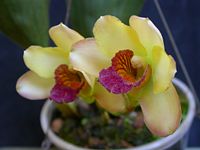 Bifrenaria harrisoniae
| ||||||||||||||||||||
| Scientific classification | ||||||||||||||||||||
| ||||||||||||||||||||
| Type species | ||||||||||||||||||||
| Bifrenaria atropurpurea Lindl. 1832 | ||||||||||||||||||||
| Species | ||||||||||||||||||||
| ||||||||||||||||||||
| Synonyms | ||||||||||||||||||||
Bifrenaria is a genus of orchids containing twenty South American species. some of which rank among the favorites of orchid growers because of their abundant showy flowers, which are large and very fleshy and at first glance seem to be artificial flowers made of wax. There are no known uses for them other than ornamental.
Despite having few species, the genus can be split in two clearly distinct groups:[1] one of highly robust plants with large flowers, that encompass the first species to be classified under the genus Bifrenaria; other of more delicate plants with smaller flowers occasionally denominated Stenocoryne or Adipe. There are yet two other species that normally are classified as Bifrenaria but which molecular analysis indicate to belong to different orchid groups. They are Bifrenaria grandis, endemic of Bolívia, which many taxonomists denominate Lacaena grandis,[2] and Bifrenaria steyermarkii, inhabitant of northern Amazon Forest,[3] which does not have an alternative classification as yet.
Distribution
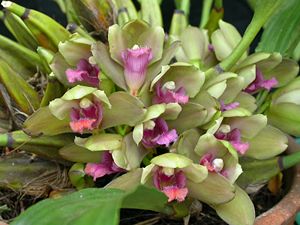
Bifrenaria inodora
Despite described with the name of B. inodora, this large species is one of the most fragrant Bifrenaria. It has two main varieties, the one on the photo was also described as B. fuerstenbergiana and has this varietal name, the other one is greener and has a yellow labellum.
Bifrenaria exist from the north of South America, one species reaching Trinidad, until Rio Grande do Sul, the farther south State in Brazil, however they are split in two isolated areas:[4] Amazon Forest and Atlantic Forest of Brazil. The later, where seventeen species are present, may be considered their recent center of distribution. The mountain area of Rio de Janeiro State and Espírito Santo is particularly rich with fifteen species registered. Serra dos Órgãos mountains area, in Rio, is reported as habitat of fourteen Bifrenaria species,[5] however, some of these species are considered synonyms today,[6] being eleven a more realistic number of species existing in the said area.
The species with large flowers are more common on Region Southeast of Brazil, however, they inhabit from the sunnier areas of the seashore to rocky mountain areas of Minas Gerais e Bahia States, from almost sea level up to 2,000 meters of altitude, some species reaching Rio Grande do Sul state.[7] No species of large flowers exist in Amazon Forest. Some species grow directly attached to the famous Sugarloaf Mountain in Rio de Janeiro which can be observed by the commuters in the cable car. The recent centers of irradiation of this group are the seashore close to Serra do Mar chain of mountains, and the high chains of mountains of Minas Gerais.[8] The most common species in this group, spread from Rio Grande do Sul to Bahia, is B. harrisoniae.[9]
The smaller species of Bifrenaria, which some taxonomists classify under the genus Adipe, are more common on less sunny areas and can be found between 300 and about 1,600 meters of altitude.[5] Six species are native in Serra do Mar Chain of mountains and its arms, place considered the center of distribution of the small species. Only three small species inhabit Amazon, B. longicornis, which is more common at low altitudes;[10] Bifrenaria venezuelana, up to 1,450 meter of altitude, and B. steyermarkii from even higher altitudes, in Roraima State, in Brazil, and nearby areas in Venezuela and Surinam.[11]
The most common species is B. aureofulva,[12] however, because the geographic characteristic of its territory, without obstacles, B. longicornis is the species spread throughout the largest area, reaching Colombia, Venezuela, Peru, Surinam, Guyanas, Trinidad and all Amazonic area in Brazil.[13] Two species seem to be endemic in highly restricted areas: B. silvana. discovered in 1987 at Serra da Ouricana mountains, nearby Itororó, in Bahia which belongs to Adipe group;[14] and B. verboonenii, discovered in September 1995 on Serra do Cipó mountains, close to Diamantina, Minas Gerais, of the large Bifrenara group.[15]
Bifrenaria species inhabit three different environments. The large species generally live in well illuminated areas, occasionally epiphyte on trees of sparse foliage, more often as lithophytes, in campos rupestres, montane rocky areas that exist mostly in Rio and Minas Gerais States of Brazil, or over rocks in jungle's clearances. B. tyrianthina is exclusively lithophyte,[16] B. tetragona and B. wittigii hardly ever do. B. atropurpurea is the only species found living terrestrially, but in rare occasions. The large species always show .[10]
The small species from Southeast Brazil live in cloud montane forests, where the appear in much darker places than the large species. Within this sort of forests the temperature presents noticeable difference between day and night and also through the seasons. These also are plants of caespitous growth, almost all epiphytes, despite there is at least one record of Bifrenaria aureofulva living lithophylically in Chapada Diamantina, Bahia.[17]
The species from Amazon inhabit tropical lowland forests and equatorial forests. Bifrenaria longicornis is mostly found in flood areas along the igapós and igarapés (seasonal flood streams and small rivers of Amazon), and occasionally in open fields where the humidity is high and temperature constant through the year, normally in well illuminated places, although not under direct sunlight.[18] B. venezuelana inhabits forests in higher elevations, closer to the Andes.[19] Amazon species are epiphyte and the only Bifrenaria species with elongated rhyzome and ascendant growth.
Description
Bifrenaria generally are robust plants, of sympodial growth, which measure between ten and sixty centimeters height. Characteristics of an orchid to be classified under this genus are: to show roots of round section with thick vellamen; four angled fleshy pseudobulbs of one internode, often basally protected by dried steaths and with only one apical leaf, except for Bifrenaria steyermarkii, which occasionally has two;[20] plicate enervated leathery leaves, yet malleable and not exceedingly thick, with a pseudopetiole of basal round section; basal inflorescences bearing up to ten flowers, which seldom surpass the leaves length.[8]
Bifrenaria flowers are fragrant or have a strong scent, they have sepals slightly larger than the petals, the lateral ones basally united to the column foot forming a calcar with truncated extremity; labellum variously shaped, often hairy, articulated to the column, with a longitudinal channeled callus often with a basal claw; the column is slightly arching, generally without wings or any other appendages, bearing a foot which the labellum is hinged to; they show two elongated stipes, hardy ever one, at least twice longer than wide, with salient viscidium, visible caudicles and retinacle in inverted positions; four hard superposed pollinia, protected by a deciduous incumbent anther.[10] The fruits are green, erect or pending, take about eight months to ripe and hold hundreds of thousand yellowish or brownish elongated seeds up to 0.35 mm long.[21] Among all the mentioned, the main characteristic to distinguish Bifrenaria form its related genera is the presence of the calcar on its flowers.[8] Other important qualities are the four sided unifoliated pseudobulbs besides the raceme inflorescence with to ten flowers.[22]
Few is known about Bifrenaria species pollination. Apparently the only existing records report the presence of some large species' pollinaria observed on the back of male Eufriesea violacea, Euglossinae bees,[23] and of Bombus brasiliensis, Bombini bees.[24] Although there is no information of direct observation flower pollination, a research published in 2006 studied the micromorphology of the labellum of Bifrenaria species searching for substances useful to insects as food:[25] The absence of these substances on the densely pubescent surface of most Bifrenaria labelli in fact seems to indicate possible pollination by large bees as the mentioned before. Other indicator of this possibility is the strong smell emanated by some species, as B. tetragona, similar to the ones of other families flowers which are pollinated by these bees. The smaller species yet pubescent may be pollinated by smaller bees species ant the smooth ones which have strong colored flowers, as B. aureofulva, by hummingbirds.[25]
Bifrenaria are comparatively easy to grow orchids. They should be preferably potted on well drained vegetable fiber because their roots and pseudobulbs get rotten easily when kept humid for long periods. As previously mentioned three different environments are needed in accordance to the species origin to successfully grow these plants. The large species need more light than the rest. The small species from Brazilian Southeast may be cultivated at the same medium temperature but under less 10 to 20% luminosity. Bifrenaria from Amazon forest need higher and more constant temperature and humidity than the other species. All species need more water and fertilizer during their active growth season.[8]
Taxonomic notes
The genus Bifrenaria has been trditionallt classified under Bifrenariinae subtribe of tribe Maxillariae, Epidendroideae subfamily, however, the relationships among the several genera within this tribus are not well defined and changes are foreseen for next years. The genus closest to Bifrenaria is Rudolfiella. Other related genera are Teuscheria, Guanchezia, Hylaeorchis and Horvatia, besides the more distant Scuticaria and Xylobium. Recently is was suggested the unification of subtribes Lycastinae, Maxillariinae and Bifrenariinae, however, there is no consensus on the path to be followed.[26] Contrary to what was previously thought, the relationship among Bifrenaria al all these genera from Central America seems to indicate a primitive origin of Bifrenaria in Central America and its posterior dissemination towards the Southeast of Brazil, where it found fertile grounds to its more recent evolution.[10]
In 2000, the first more complete molecular analysis on Bifrenaria species were made.[10] Sixteen species of this genus and six of close genera were studied searching for conffirmation of their phylogenetical position, besides the delimitation of each species and each of Bifrenaria's groups. The obtained results do not allow the acceptance of genus Adipe and, although they confirm Cydoniorchis monophyly, they dissuade their use otherwise six other genera should need to be created to fulfill the remaining fifteen species. They discuss also the convenience of splitting two species that are similar to each other and variable among themselves, with many hard intermediate forms hard to delimitate as B. charlesworthii and B. racemosa. It is also confirmed the position of B. steyermarkii out of Bifrenaria yet no genus name is suggested.
The first species to be described, today classified as a Bifrenaria, was initially denominated Dendrobium harrisoniae by the author of its description, the English Botanist William Jackson Hooker,[27] now Bifrenaria harrisoniae. In 1827, Hooker described the first species of the small ones group, B. racemosa, however, classified it under the genus Maxillaria.[28] With this two publications started a long series of species descriptions and confusing genera about which many doubts existed during the two following centuries. The Royal Botanic Garden registers the submission of 69 species or ou varieties under genus Bifrenaria since the description of the first species.[4] Among these, twenty are generally accepted but only seventeen are well established, having no doubts about their true limits and classification. Thirteen species are accepted but now belong to other genera; and four or five, due to deficiencies on their descriptions, possibly will never be solved. The remaining species and varieties are synonyms of the accepted ones.[10]
Few years later, in 1832, John Lindley proposed the genus Bifrenaria when describing its type species, Bifrenaria atropurpurea,[29] previously described by Loddiges as Maxillaria atropurpurea.[30] The name Bifrenaria comes from bi, two, and freno, brake, a reference to the shape of the two pairs of pollinia hold by separated caudicles presented by its flowers.[8]
In 1837, Constantine Samuel Rafinesque, considering the noticeable vegetative difference between the few Bifrenaria known at the time, proposed the genus Adipe, based on B. racemosa morphology, described by Hooker few years before, to which added the description of a supposed new species, today considered its synomym, with the name of Adipe fulva.[31] On next year Lindley received a specimen of B. longicornis from Amazon, which was morphologically even more distant from the known species, however, he described it as Bifrenaria. Five years later, apparently not aware of Rafinesque's previous genus Adipe, changed his mind and suggested that this species should be classified under a new genus, Stenocoryne.[32] While six species were attributed to Lindley's genus Stenocoryne by several taxonomists during following years, the genus Rafinesque proposed remained forgotten until 1990.[4]
Two species similar to Bifrenaria but that show a highly salient claw at the base of the labellum and lateral lobes abruptly divided, were then classified under this genus. In 1914, Rudolf Schlechter, based on Rudolfiella aurantiaca which presented the mentioned differences, suggested they should be classified under the genus Lindleyella, however this genus name was already occupied by plants of Rosaceae family.[33] Just thirthy years later, in 1944, the Botanist Frederico Carlos Hoehne, when working on the first revision of genus Bifrenaria corrected the suggestion of Schlechters. Hoehne initially proposed the genus Schlechterella to these species but, coincidentally, this name was also taken, now by Asclepiadaceae family plants.[34] Finally another name in homage to Schlechter was chosen, Rudolfiella, at the time with the number of species already increased to seven. On this revision, besides Rudolfiella, Hoehne divided Bifrenaria into two genera, therefore accepting the genus Stenocoryne proposed by Lindley but calling attention to the existence of Rafinesque's genus Adipe, which should have name priority over Lindleys and also raised doubts about the identity of several described species.[35] In 1990, Manfred Wolff resurrected the genus Adipe and to it submitted ten Bifrenaria species, besides the two already described by Rafinesque, however, not justifying his critters not revising the species.[36]
Making the picture even more complex, in 1994, Karheinz Senghas, based on several characteristics shared only by B. tetragona and B. wittigii, described the genus Cydoniorchis to accommodate them.[37] In 1996, Gustavo Romero and Germán Carnevali transferred to Bifrenaria a species originally described by Schlechter as Maxillaria petiolaris, now classified as Hylaeorchis petiolaris.[38] On the same year, Vitorino Castro Neto published the most recent revision of Bifrenaria and its five sections, which is the classification used today.[39]
Species
Bifrenaria is formed by about twenty species[4] divided in two main groups of plants, large and small, with some visible morphological subdivisions highly confirmed by phylogeny.
Large species: is the group originally classified as Bifrenaria. They present four sided pseudobulbs, with relatively short and erect inflorescence bearing up to ten fleshy large flowers but generally less. Usually the flowers are grouped and are fragrant or exhale strong scent. The labellum has three or four lobes and an elongated low callus. They are epiphytes, or often lithophytes. All originated in the southeast of Brazil. This group can be split in three subgroups:[10]
- The first subgroup is formed by plants that show a pollinarium with entire stipe and a salient callus just on its anterior region. The species are two, Bifrenaria calcarata, That has the intermadiate lobe of the labellum approximately triangular and the lateral ones square, and B. mellicolor, which has more rounded lobes. These species are similar and preferably epiphytes.
- The second subgroup also is formed by plants that show a pollinarium with entire stipe but the callus is entirely salient and fleshy. It is formed by the two species Senghas moved to genus Cydoniorchis, Bifrenaria tetragona that presents a totally smooth labellum with rounded apex, and B. wittigii, that has a partially pubescent labellum of acute apex.
- The third subgroup é formed by the four species with a bifurcated stipe: Bifrenaria atropurpurea, the only one with a cuneated viscidium; B. tyrianthina, the only to have rounded viscidium; B. inodora with greenish flowers and two lobed callus; and B. harrisoniae, highly variable species of several colors, that always has three lobed callus on the labellum. The species of this group are often or exclusively lithophytes.
- Bifrenaria verboonenii placement is not well defined so far, yet surely among the large species.
Small species: is formed by the plants that once belonged to Stenocoryne, or more accurately, Adipe, which normally are epiphytes. They present smaller and not as noticeably four sided pseudobulbs, and long and delicate inflorescence bearing a higher medium number of flowers than the large species, although also never surpassing ten. The flowers are smaller and not fleshy, with an entire labellum, or sometimes slightly lobed on the apex. These species take less luminosoty and more humidity than those and are not particularly fragrant. According to their morphology they can be split in four distinct subgroups:[10]
- The first subgroup is formed by the two Amazonian species, with elongated rhyzome: Bifrenaria venezuelana, that has short inflorescence and highly reduced calcar; and Bifrenaria longicornis, with long inflorescence and noticeable calcar.
- Within the second subgroup there is only Bifrenaria aureofulva, easily identifiable because of its bright orange flowers with acute sepals, petals and labellum, which do not open well.
- The third subgroup is formed by the two species which present petals que apresentam petals parallel to the column; These two species are hard to separate due to the high number of intermediate varieties: Bifrenaria charlesworthii, that has more open and hairy flowers; and a Bifrenaria racemosa.
- The last subgroup is formed by species that present petals oblique to the column. Two have petals and sepals marked with other colors: Bifrenaria clavigera, that has a calcar formed by the fusion of the lateral sepals bases, and Bifrenaria silvana where the calcar is a result of their superposition; Bifrenaria leucorhoda has white flowers with labellum veined of pink color. The two remaining species have highly similar yellow flowers, although of diverse sizes, the smaller and often paler is Bifrenaria stefanae, the larger and of brighter color is Bifrenaria vitellina.
Other species: the remaining species are plants about which classification consensus has not been achieved: Bifrenaria maguirei, also classified under the genus Guanchezia, and Bifrenaria grandis, under Lacaena. Bifrenaria steyermarkii is a species highly different from all other Bifrenaria because its inflorescence is very long ant its flowers highly narrow, therefore it does not fit in any group, nevertheless the only other option of classification that has been published so far is under Xylobium what possibly is not a choice either.
References
- ↑ Cogniaux, Celestin A.(1902). Bifrenaria in Flora Brasiliensis K.F.P.von Martius & auct. suc. (eds.) vol.3 p. 5: 476. published on Internet.
- ↑ Kraenzlin, Friedrich Wilhelm Ludwig (1928). Lacaena grandis in Repertorium specierum novarum regni vegetabilis. Ed. Selbstverlag des Herausgebers, Berlin, at vol.25: 25.
- ↑ Dunsterville, Galfried Clement Keyworth & Garay, Leslie A. (1976). Bifrenaria steyermarkii in Venezuelan Orchids Illustrated vol.6: 56. London.
- ↑ 4.0 4.1 4.2 4.3 R. Govaerts, M.A. Campacci (Brazil, 2005), D. Holland Baptista (Brazil, 2005), P.Cribb (K, 2003), Alex George (K, 2003), K.Kreuz (2004, Europe), J.Wood (K, 2003, Europe): World Checklist of Orchidaceae. The Board of Trustees of the Royal Botanic Gardens, Kew. Published on the Internet. (Access March 2009).
- ↑ 5.0 5.1 Miller, David , Richard Warren, Izabel Moura Miller & Helmut Seehawer (2006). Serra dos Órgãos sua história e suas orquídeas. Rio de Janeiro.
- ↑ Koehler, S. & do Amaral, M.D.E. (2004). A taxonomic study of the South American genus Bifrenaria Lindl. (Orchidaceae). Brittonia 56: 314-345.
- ↑ Castro Neto, Vitorino P. (2006). Bifrenaria atropurpurea in Icones Orchidacearum Brasilienses. ISBN 8590149447
- ↑ 8.0 8.1 8.2 8.3 8.4 Frederico C. Hoehne (1953). Bifrenaria in Flora Brasílica, Vol 12: 7. Instituto de Botânica de São Paulo.
- ↑ Castro Neto, Vitorino P. (2006). Bifrenaria harrisoniae in Icones Orchidacearum Brasilienses. ISBN 8590149447
- ↑ 10.0 10.1 10.2 10.3 10.4 10.5 10.6 10.7 Koehler, Samantha (2001). Estudo taxonômico e análise cladástica do complexo Bifrenaria Lindl. (Maxillarieae, Orchidaceae). Universidade Estadual de Campinas. Instituto de Biologia. Published on the Internet
- ↑ Freitas Luz, Francisco J. (2001). Orquídeas na Amazônia. Instituto Brasileiro de Cultura, Ed. On Line. ISBN 8520802087
- ↑ Lindley, John (1843). Bifrenaria aureofulva in Edwards's botanical register 29: t.52. Ed. James Ridgway, London.
- ↑ Lindley, John (1838). Bifrenaria longicornis in Edwards's botanical register 24: t.93. Ed. James Ridgway, London.
- ↑ Castro Neto, Vitorino P. (1991). Bifrenaria silvana in Boletim CAOB 3(4): 41.
- ↑ Romero, Gustavo A. & Castro Neto, Vitorino P. (2000). Bifrenaria verboonenii in Harvard Papers of Botany 5: 187 Cambridge.
- ↑ Toscano de Brito, Antonio & Cribb, Phillip (2005). Bifrenaria tyrianthina in Orquídeas da Chapada Diamantina. Ed. Nova Fronteira. ISBN 8520917828
- ↑ Toscano de Brito, Antonio & Cribb, Phillip (2005). Bifrenaria aureofulva in Orquídeas da Chapada Diamantina. Ed. Nova Fronteira. ISBN 8520917828
- ↑ Miranda, Francisco (2006). Orquídeas da Amazônia Brasileira. Ed. Expressão e Cultura, 1996. ISBN 8520802087
- ↑ Castro Neto, Vitorino P. (2002). Bifrenaria venezuelana in Icones Orchidacearum Brasilienses. ISBN 8590149447
- ↑ Foldats, Ernesto (1970). Xylobium steyermarkii em Novedades Cientificas, Contribuciones Occasionales del Museo de Historia Natural La Salle vol.35: 1. Serie Botanica. Caracas.
- ↑ Dressler, Robert L. (1993). Phylogeny and classification of the orchid family. Cambridge University Press.
- ↑ Campacci, Marcos A. (2003). Coletânea de Orquídeas Brasileiras II, Bifrenaria. Ed. Brasil Orquídeas. ISSN 16785606
- ↑ Dressler, Robert L. (1990). The orchids natural history and classification. London: Harvard University Press.
- ↑ Singer, Rodrigo B. & Koehler, S. (2004). Pollinarium morphology and floral rewards in Brazilian Maxillariinae (Orchidaceae). Annals of Botany 93: 39–51.
- ↑ 25.0 25.1 Davies, K.L. & Stpiczynska, M. (2006). Labellar Micromorphology of Bifrenariinae Dressler (Orchidaceae). Annals of Botany Company. Oxford University Press. published on the Internet
- ↑ Whitten, W. Mark, Williams, Norris H. & Chase, Mark W. (2000). Subtribal and generic relationships of Maxillarieae (Orchidaceae) with emphasis on Stanhopeinae: combined molecular evidence. American Journal of Botany. 2000;87:1842-1856. Published on the Internet
- ↑ Hooker, William Jackson (1824). Dendrobium harrisoniae in Exotic Flora. 2: t. 120. Edinburgh.
- ↑ Hooker, William Jackson (1827). Maxillaria racemosa in Botanical Magazine vol. 54: t. 2789. Curtis Ed., London.
- ↑ Lindley, John (1832). Bifrenaria in The Genera and Species of Orchidaceous Plants: 152.
- ↑ Loddiges, Conrad L. (1832). Maxillaria atropurpurea em Botanical Cabinet vol.19: t.1877. London.
- ↑ Rafinesque, Constantine Samuel (1837). Adipe em Flora Telluriana vol. 2: 101.
- ↑ Lindley, John (1843). Stenocoryne in Edwards's botanical register 29(Misc.): 53 Ed. James Ridgway, London.
- ↑ Schlechter, Rudolf (1914). Lindleyella in Orchideen: 414.
- ↑ Hoehne, Frederico Carlos (1944). Schlechterella in Arquivos de Botânica de Estado São Paulo, n.s., f.m., 2: 13.
- ↑ Hoehne, Frederico Carlos (1944). Rudolfiella in Arquivos de Botânica de Estado São Paulo, n.s., f.m., 2: 14.
- ↑ Wolff, Manfred (1990). Adipe em Orchidee (Hamburg) 41: 36.
- ↑ Senghas, Karlheinz (1994). Cydoniorchis em Journal für den Orchideenfreund 1: 11.
- ↑ Romero, Gustavo A. & Carnevali, German (1996). Bifrenaria petiolaris em Richard Spruce: Botanist and Explorer 180.
- ↑ Castro Neto, Vitorino P. (1996). Contribution to the study of the genus Bifrenaria. Proceedings of the 15th World Orchid Conference. Turriers, Naturalia Publications, Rio de Janeiro, pp. 376-383.
